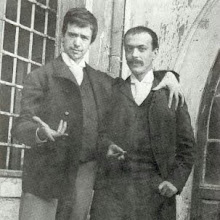






Conscious-eating guru Michael Pollan once advised, “Don’t eat anything your great-great-grandmother wouldn’t recognize as food.” Increasingly, greenmarket growers, artisanal brewers, farm-to-table restaurants, and other adherents of seasonality and craft are looking to the past as they design their menus, packaging, websites, and interiors. Tapping into the eclectic stylistic energies of the 19th century, they’ve created an antique aesthetic as contemporary as grass-fed beef.
But would our great-great-grandmothers have been unanimous about the wholesomeness of foods like “artificial brown butter” or meat and vegetable extracts? What do modern espresso purists think of “coffee” made with once-common additives like figs, chickpeas, and dandelion root?
Today’s revival of blocky wood type and fine-lined lithography is a reminder that the late 19th and early 20th centuries were hardly an age of agrarian innocence, but an untrammeled experiment in mass-produced media and food. Industrialization, adulteration, lab-derived food products, and global trade were already creating anxieties familiar to those of today’s consumers who are haunted by fears of trans fats and melamine. As companies outgrew the reach of personal reputation (becoming “anonymous societies,” in European parlance), they adopted visual brands—protected by new trademark laws—to build consumers’ trust.
An archive in Trieste, Italy, offers a vivid early snapshot of food makers’ designs for their new public identities. Until World War I, Trieste was the entrepôt of the Austrian empire, where raw materials were processed into food products for all of Europe. The Trieste Chamber of Commerce and Industry started registering trademarks under Austrian law in 1867, and its Museo Commerciale contains original prototypes of hundreds of late-19th- and early-20th-century food marks in its archive.
A Deco-style 1933 trademark for the "Flotten" ("Fleets," in German) brand of Arrigoni, a Trieste food company famous for its boullion cubes.
This little-visited museum occupies a building that encapsulates the city’s commercial and gustatory history: a neo-
Baroque palazzo built for the Hungarian brewer Dreher, with a grand restaurant later converted into a stock-trading floor. Across the street is Da Pepi, from 1897, one of Trieste’s Slow Food–certified eateries. Illustrating that one age’s tradition is another’s innovation, it’s an early form of fast food: a raucous kind of pork delicatessen called a buffet
Many, of course, picture food: a hen perched on a giant, lustrous egg, registered in 1905 by an egg-pasta manufacturer; or a brilliant red langoustine for a purveyor of “delicacies” (1909). Some makers were more eager to show off their technological advancements. Another pasta company, in 1908, displayed the requisite eggs as a seeming afterthought to a picture of its “prize-winning steam-powered” factory. Tropical landscapes explain the distant origins of rum or fig coffee additive, with florid type trumpeting the power to bring them to the European table.
But not all “food” was so easily recognizable. Margarine was a new invention in the 1870s, and synthesized cooking fats were common sidelines for companies that made soap, candles, and industrial greases. Trademarks for such newfangled products were often correspondingly abstract—forbidding geometric monograms that glorified intellectual property rather than natural bounty.
In food and in design, we choose the past that suits our present. But today’s nostalgia is a faint aroma compared with these forgotten sensations. These companies were still overwhelmingly “local,” and few survived the modernizing process they contributed to. The earliest marks betray the simple need to differentiate one firm’s goods from another’s, with hand-drawn letters, stars, and circles. As they became more elaborate, they drew on some recognizable conventions, like heraldry, with its eagles, banners, radiant suns, and lions. The winged lion of St. Mark, emblem of Venice—and therefore of Italy—drowses over a cup of Tè Italia tea in a logo from 1919, a year after Trieste became part of Italy. Even Uncle Sam sips a presweetened “coffee preparation” amid an eye-popping swirl of the freely interpreted Stars and Stripes (1907).
But we can’t fully reconstruct the meaning of many of the whims and enthusiasms of these entrepreneurs and anonymous artists. We do know that a century ago, as today, eating well served “both to epitomize modern life and to offer an antidote to modernity’s ills,” in the words of the food geographer Susanne Friedberg. Taking this near past as our food model, we can choose to eat what strikes us as natural, even if that choice became thinkable only with industrialization and globalization. After all, we can’t escape the condition of modern eating, which
is to think about our food—to carry, in our cravings and in our shopping bags, an idealized image of it.
http://www.ts.camcom.it/proposte-del-territorio/proposte-del-territorio-museo-commerciale/




Nessun commento:
Posta un commento